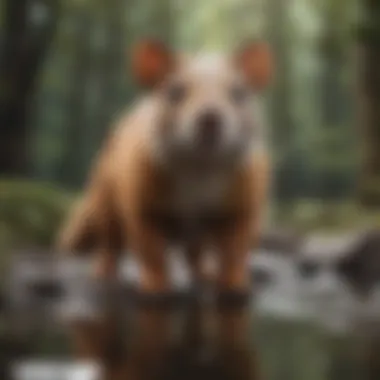Exploring the Intriguing World of Unusual Animal Names


Nature Topic Overview
Animals have wonderful ways of grabbing human attention with their unusual and often humorous names. This exploration into odd animal names will help articulate not just what creatures share the earth with us, but the meanings behind their names as well. These names can be rich in history and science, offering insights that broaden our understanding of the natural world.
We find that names often reflect the anatomy of an animal, its geographic habitat, and unique behaviors. For example, the name Axolotl references the Aztec god of lightning and it is native to Mexican lakes. Becoming familiar with weird animal names encourages curiosity and appreciation in children about biodiversity, which is crucial for life on earth.
Through this article, we will look at fun facts, provide trivia to ignite minds, and encourage the next generation to engage with the wild where these unique beings exist.
Fun Facts and Trivia
- Did you know that the Goblin Shark has a snout that resembles a goblin's nose?
- The Blue-footed Booby gets its name from its bright blue soles that it uses in courtship displays.
- Among species, such as the Numbat, its name doesn't reflect its striking unique look adapted to the diet of termites.
- Pangolins are the only mammals fully covered in scales.
Prelude to Weird Animal Names
Understanding unusual animal names opens a doorway to the captivating complexities of biodiversity and linguistic diversity. The names not only reflect how humans perceive these creatures but also reveal secrets of habitat, behavior, and culture. It serves as a reminder of the vastness of the animal kingdom and how naming conventions can differ remarkably across regions around the globe.
What Defines a Weird Name?
To comprehend what makes an animal name weird, we consider several attributes. A weird name may be derived from unexpected physical or behavioral traits, or it might stem from quirky cultural interpretations. For instance, the name
Animals with Unusual Names from Around the World
Exploring animals with unusual names offers insight into linguistic diversity and cultural identity. Each region presents its unique nomenclature, reflecting history, behavior, and even geography. This exploration serves as a delightful means of engaging the natural world, especially for young minds curious about how words resonate with the living beings that inhabit our planet. By contrasting names stemming from various locations, children and adults alike can appreciate the collective creativity embedded in language. It inspires learners to explore further into the realms of biology and ecology, illuminating the diversity of life.
Regional Variations in Animal Names
Names of animals can change dramatically depending on the part of the world they come from. Regional differences reveal not only cultural distinctions but also local perspectives on the fauna. For example, animals might be called differently according to language, folklore, or even the shared environment. Understanding these names encourages conversations about cultural backgrounds and locality.
Some important aspects involve:
- The role of indigenous languages in naming animals
- How folklore shapes perceptions of certain species
- Variations based on geography and ecology
Specifically, a name like the red kangaroo might evoke different imagery and meaning in Australia compared to a country far from its habitat.
Examples from North America
In North America, moose is a widely recognized animal, yet its name derives from the Algonquian words meaning “eater of twigs.” This showcases a specific understanding of the animal’s habits, vital for early Native American cultures.
Specific examples include:
- The nightjar: Known for its unique calls and well-camouflaged appearance.
- The mountain goat: Finds its name reflective of its high-altitude habitat.
These names enhance the connection between inhabitants and their surroundings.
Examples from South America
South America’s rich biodiversity is reflected in its animal names. The pudu, the smallest deer in the world, has a name from the indigenous Mapuche language, and illustrates the affinity local communities have towards the forest creatures.
Other notable cases feature:
- Bufonidae, commonly known as toads, often named based on their sounds in various regions.
- The Capybara, known for its social nature and also influenced by wildlife stories.
These instances illustrate how names capture experiences with nature.
Examples from Africa


In Africa, names derive substantially from community interactions and the ecological environment. The term for hyena can differ significantly; for instance, its misinterpretation can highlight the contrast between its reputation and actual behavior.
Animals possibly included:
- The African elepant, which comes from historical uses of the animal across cultures.
- The African wild dog, promoting their difficulty in classification due to their pack behavior.
This illustrates how language expresses both cultural pride and fear.
Examples from Asia
Asia features a vast array of languages, leading to intriguing animal names. For instance, the sunda pangolin, whose name relates to its scale covering, enhances understanding of its unique physicality.
Key examples:
- The Bengal tiger, enriched by cultural significance in mythology.
- The Asian elephant, further illustrating conservation challenges tied to its loose naming adaptations.
Delving into these names presents a means of discussing wildlife preservation.
Examples from Australia
Australia holds a special place in the world of unique animal names, with terms like platypus. The origins hail from the Greek “flat foot”, aligning with the animal's distinct features.
Highlighted species:
- The koala, derived from Aboriginal words to describe its habits.
- The Tasmanian devil, illustrating a cultural blend between earlier settlers and wilderness.
Each name contributes back to Australian cultural views around animals.
Examples from Europe
In Europe, its naming conventions often tie back to ancient roots. The wolf, found throughout its open landscapes, derives from Old English. This reinforces its strong connections to human folklore.
Some interesting titles:
- The Eurasian beaver, known for its secondary habitat in rivers and effects on environments.
- The red deer, noted in various local stories from ancient times along with its hunting heritage.
Names embody substantial historical narratives, thus enriching each community's animal understanding.
The world of animal names is a doorway into greater cultural engagement. Each name is not just a label but a reflection of local customs, beliefs, and history.
The Linguistic Origins of Animal Names
The names given to animals are not just arbitrary labels. They carry a deep connection to the languages and cultures from which they emerge. This section explores the origins of animal names and explains their significance. Understanding the linguistic roots of these names enriches our appreciation of biodiversity and underscores the intricate ties between language and the natural world. Through this exploration, readers will grasp the richness found in the origins of animal names and how culture and language shape the way we recognize each creature.
Latin and Greek Influence
Latin and Greek languages have greatly influenced how we name animals today. Many scientific names for animals come from these languages and are structured in a special way known as binomial nomenclature. This system, invented by Carl Linnaeus, uses two parts for each name: the genus and the species. For example, the common lion is named Panthera leo.
Understanding this might seem complex, but it is essential for scientists to consistently identify and communicate about species worldwide.
Some examples of animal names influenced by Latin and Greek include:
- Cumulatively informative: The word curtis relates to sitting in Latin and describes animals that are often seen stationary or resting.
- Feline origins: The scientific name for cats, Felis catus, illustrates a combination of Felis, which means cat, in Latin and catus meaning domestic or tame.
Knowing these languages helps to measure animal phylogeny and patterns in naming that can bring clarity to their histories and classifications.


Indigenous Languages and Naming Conventions
Indigenous languages provide another layer of insight into animal names. Many cultures have their own unique ways of naming animals based on geography, behavior, or symbolism. The names adopted often reflect the importance of these animals in local ecosystems and cultural narratives. Such naming conventions create a broader understanding of the environmental relationship that communities have with animals.
For instance, some Native American tribes have various names for the eagle, each signifying different characteristics or meanings. Here are some examples:
- The Ojibwe call the eagle Migizi, which solidifies the eagle's cultural relevance.
- Indigenous Australians name animals based on appearances: the Redback Spider refers to not just its color but also its characteristics that relate to its environment.
In a global context, traditional naming helps reveal how people connect with and perceive different species. Options like humanizing animals give cultural importance as well.
The richness of animal names reflects a wealth of knowledge: history, identity, and empathy woven together through languages.
Through exploring both Latin/Greek and indigenous languages, we see the multifaceted nature of animal names and how they contribute to our understanding of biodiversity. This linguistic lineage is pivotal, connecting children and adults alike to the larger narrative of nature and its inhabitants.
Anatomical Features Reflected in Animal Names
Recognizing how anatomical features play a role in naming animals reveals a lot about their characteristics. The connection between physical traits and animal names informs both scientific and common naming practices. It's crucial because it helps us understand not just the animals themselves, but also their habitats and behaviors. When names reflect anatomy, they often give insight into adaptations, survival strategies, and environments. This glimpse can inspire curiosity in young learners, encouraging them to look closely at the unique beings they might encounter in nature.
Unique Physical Characteristics
Certain animals are easily identified by their unique physical characteristics, which is often a significant part of their names. For example, the Pygmy Marmoset is named for its small size, standing to just about 5 inches tall. These tiny monkeys live in the lush canopies of the Amazon Rainforest, moving easily between tree branches. Other examples include the Swallow-tailed Kite, which has a distinct tail that resembles a swallow, greatly assisting in airy flight maneuvers. Understanding these unique characteristics helps children appreciate the diversity in the animal kingdom. A fascination with these quirks can lead to broader discussions about biodiversity and conservation.
- Pygmy Marmoset: Smallest monkey species.
- Swallow-tailed Kite: Named for its shuttle-like tail shape.
Adaptive Features and Their Namesakes
Adaptive features are vital for survival in varying environments, and sometimes that's reflected in the names of animals. Take the Hammer-headed Bat, for instance. Its name comes from its unique head shape, which aids in attracting mates and echolocation, sound for movement. Similarly, the Narwhal is often referred to as the
Behavioral Traits and Their Names
Understanding behavioral traits and their connection to animal names is key to appreciating how we classify animals. These names are often inspired by observable actions, which can inform conservation status and societal values. In this section, we will uncover naming conventions directly tied to behavior, offering insight into how these creatures interact with their environment. This connection can foster curiosity in young learners, prompting them to observe real-life behaviors in nature.
Naming Animals Based on Actions
Animals exhibit various actions which can be amusingly distinct or perplexing. Names based on these actions often reflect unique characteristics that help in recognizing them. For instance, the Giant Red Cssssophie (Dreamfish), recognized for its shiny scales, showcases how its name highlights an unlikely resilience when navigating through murky waters. In this context, names serve as storytelling tools that enhance our understanding of these creatures.
Furthermore, the American Pika gets its name from the distinct sound it makes, which resembles a high-pitched call. Such action-based names often become a pivotal link to studying animal sound patterns in their habitats. Etymology plays a major rol in our understanding of behavior, fostering intrigue in balancing conservation and species recognition.
- Examples:
- The Greater Rhea, known for its ground-running, ensures the readability of our observations in understanding how this flightless bird acts.
- The Dancing Frog, noted for its intriguing movements, gives hints on how physical actions translate into their identity within biral diversity.
These examples illustrate that correctly understanding behaviors ensures that we recognize their role in different ecosystems. Having knowledge of animal names linked to actions create a sense of belonging to the world while also highlighting its delicate dynamics. As the fun catches on with the playful naming, respect for biodiversity thrives naturally.
Social Behaviors Reflected in Names
Animal names can tell us about their social interactions as well. Certain species are known for forming groups or unique social structures, and their names may derive from these elements. Consider the Elephant, a name partly rooted in their famous herd behavior. Elephants are known for their deep emotional connections to fellow group members, thus earning respect through time. Their societal structures often designate ages within ranks, informing observers more profoundly about how dynamics work among groups.
The name Dolphin also reflects complexity in social behavior. Dolphins exhibit behaviors such as whistles and clicks, often interpreted as inventiveness in intricate communication. Such animal names enrich the comprehension of behaviors beyond their natural reality. They highlight aspects missed by daily inquiries into the animal world.
Cultural Significance of Animal Names
The cultural significance of animal names goes beyond mere classification. It reflects the intricate relationship between humans and the creatures they inhabit the world with. Names often serve as conduits for understanding society's beliefs, values, and experiences. They can reveal historical connections and offer insight into how different cultures interact with nature. This examination of animal names provides layers of meaning, illustrating the bond humans share with the animal kingdom.
Names can signify the characteristics, behaviors, and mythical aspects viewed through the lens of a particular culture. Understanding these names helps us to appreciate not only the animals themselves but also the cultural context they are embedded in. In this article, we delve deeper into two key areas: mythology and folklore, along with symbolism in various cultures.


Mythology and Folklore
Many animal names have roots in mythology and folklore. Different cultures use names that tell stories or incorporate moral lessons associated with the animals. Whether sacred or malevolent, these stories often transcend time, reflecting beliefs about life, death, and the universe's forces.
For instance, in Greek mythology, the owl is associated with Athena, the goddess of wisdom. The name “owl” carries significance and echoes ceremonial values that highlight intellect. Similarly, in indigenous cultures, the wolf may symbolize loyalty and courage, influencing its name in various tribal languages. Such rich narratives offer more than names; they share traditions and cultural understandings.
Symbolism in Different Cultures
Animal names also embody symbols that provide context to cultural practices. The reference to animals varies across cultures, each carrying unique meanings. For example, in some Native American cultures, the bear may represent strength and introspection. Conversely, in Chinese culture, the dragon is often seen as a symbol of power and good fortune, greatly cherishing in domestic traditions.
Adopting animals as symbols often crafts different names as well. These names reflect ideas that cultures hold about these creatures. Here are a few examples:
- Fox: Known for cunning in folklore, in some cultures the name carries negative connotations.
- Eagle: Often symbolizes freedom and strength, it has noble connotations in various cultures, especially in the United States.
- Dove: Universally recognized as a peace symbol, carrying an enormous impact in many spiritual beliefs.
Culmination on Cultural Significance
The cultural significance of animal names serves an important role in how societies view the natural world. By analyzing myths, folklore, and symbols, we can grasp not only the names but the vibrant histories they carry. Understanding these names enriches our knowledge about biodiversity and can inspire future generations to examine the wonderful canvas nature has to offer. Through recognizing the interconnections of culture, people may foster a greater appreciation for wildlife and the stories behind those names.
The names we give to animals unveil narratives about human connection and cultural meaning. In this sense, they are not just labels but bridges to understanding our shared world.
Conservation and Scientific Classification
Conservation and scientific classification play crucial roles in our understanding and appreciation of the animal kingdom. The way we classify animals helps in identifying and studying them, which is essential for conservation efforts. When animals have weird names, it often reveals important information about their behavior, anatomy, or habitat. These peculiar names can spark curiosity and fascination. By knowing more about these animals, we can appreciate their significance in the ecosystem and the need to protect them.
The Role of Scientific Naming
The scientific naming system, known as binomial nomenclature, was developed by Carl Linnaeus in the 18th century. Each species is given a two-part name that includes its genus and species. For example, the common house cat is named Felis catus. This systematic way of naming provides several benefits:
- Clarity: Each animal has a unique name. This reduces confusion from common names that vary by region.
- Standardization: Scientists can communicate about species easily, regardless of language barriers.
- Identification: Recognizing species more accurately can help in understanding their ecological roles and conservation needs.
Understanding these names can reveal how human perspectives about animals are shaped by history and culture. It can also encourage interest and respect in a wide-ranging audience thanks to their unusual aspects.
Impact of Names on Conservation Efforts
The names of animals often reflect their characteristics or habitats and can influence conservation strategies significantly. Here are a few impacts names can have on conservation:
- Awareness: A memorable animal name or unusual trait can spark people's interest and drive awareness.
- Connection: Individuals may feel more inclined to participate in conservation when they relate to the name or story of an animal. For instance, the endangered Vaquita porpoise draws attention due to its unique name and situation in the Gulf of California.
- Funding and Support: Unique names may lead to campaigns that emphasize the need for protection, affecting the amount of funding raised for conservation initiatives.
"The greater understanding we have about a species, the more effective we can be in helping to protect it from extinction."
Closure: Embracing Diversity in Animal Names
In exploring the realm of weird animal names, we find a deeper connection to biodiversity and the intricate systems that classify the living organisms around us. Understanding different animal names is not merely an academic exercise; it acts as a bridge that enhances appreciation towards the diversity of life forms our planet harbors. Each unusual name tells a story, reflecting various factors such as behavioral traits, cultural significance, or even specific anatomical features inherited through evolutionary processes.
Through naming, we glimpse into distinct regions' cultures and languages, showcasing how identity and meaning are intertwined with animal representation. Recognizing this prominence is vital as it shines a light on how diverse narratives can exist within ecological knowledge. It also inspires curiosity about the species we might encounter, fostering an interest in conservation and protecting our natural heritage.
Moreover, names inspire connections—not just between organisms themselves but also between us as humans and the larger ecological context. Names engender respect and curiosity for the environment, fostering a healthy mindset which encourages exploration beyond superficial understanding.
*"Names carry stories, and our comprehension elevates our responsibility toward future generations."
Appreciating Biodiversity
Appreciating biodiversity involves recognizing the vast array of life that coexists on Earth. Each organism is crucial to its ecosystem, and animal names serve as cultural touchstones that connect us back to these entities. Highlighting peculiar animal names from various geographical backgrounds can pique interest and spark conversations about the ecosystems supporting these lives. Through stories surrounding names like the Aye-aye of Madagascar or the Narwhal of the Arctic, we begin to see the threads connecting us to nature and instill desires to research various creatures further.
Kids, too, thrive on storytelling. Presenting weird and vibrant names can serve as a springboard for inspiration. Sharing facts about the animals themselves can also lead to a greater understanding of their roles within their habitats.
Inspiring Future Generations
Training children to appreciate the world of weird animal names fosters a sense of responsibility towards biodiversity. Understanding that every name and species plays a part in the environment creates a generation that is childless confronting larger ecological issues. Sharing and fostering such knowledge might engage children in science, protection endeavors, and exploration.
Inspiring future generations also rely on establishing connections between young individuals and nature. By cultivating interest in the oddities of animal names, children develop curiosity that often transforms into action. They become guides, stewards for nature, and advocates for countless species thriving under diverse ecosystems.
Ultimately, an understanding of animal nomenclature results in a kind of ownership. These stories found in animal names become personal as children increasingly delving into the natural world, thus allowing their experiences and stories to enrich the cultural tapestry of biodiversity.







